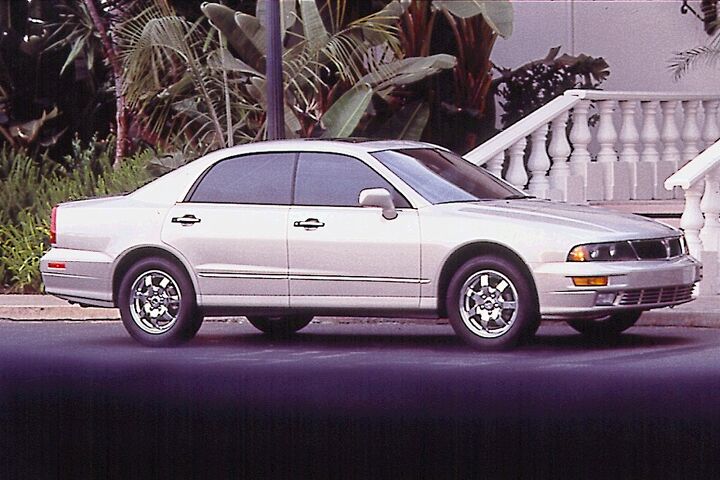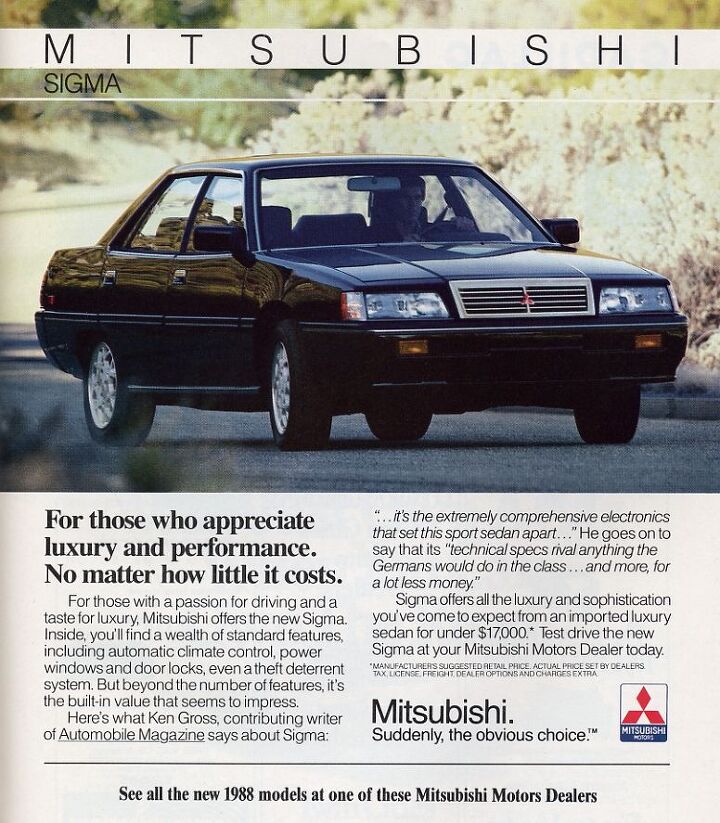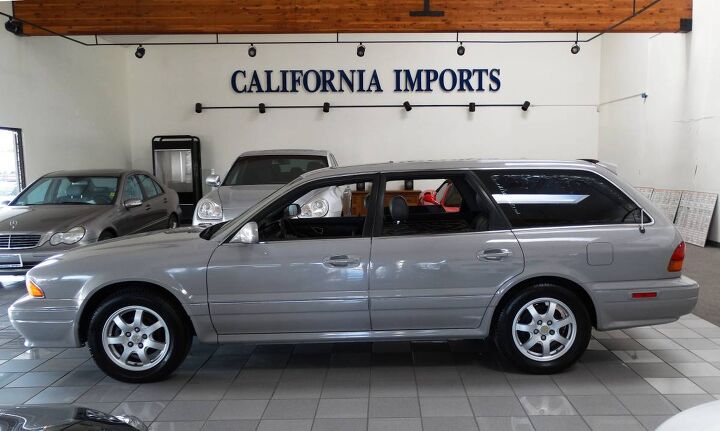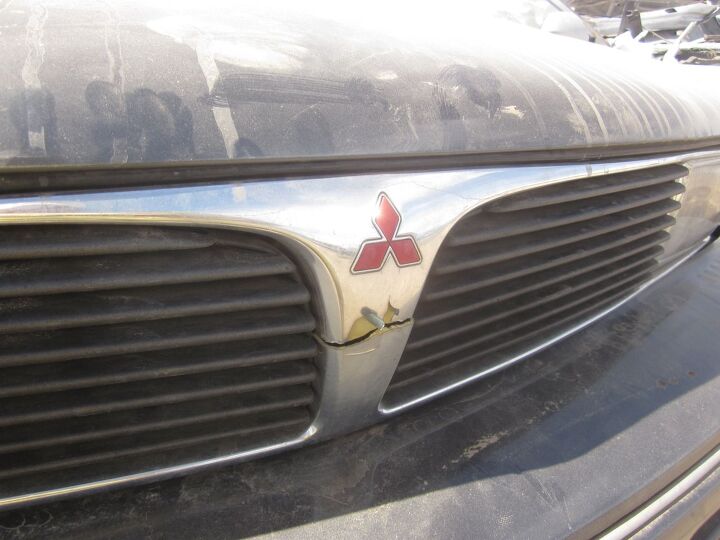#MitsubishiDiamante
Junkyard Find: 2004 Mitsubishi Diamante LS
Mitsubishi began selling cars with its own branding in the United States in late 1982, introducing three car models and a pickup as 1983 models. We had an extensive range of Mitsubishi models to choose from for quite a while, including a credible luxury sedan known as the Diamante, but those days are long gone. Today's Junkyard Find is one of the very last Diamantes sold here, now residing in a Denver car graveyard.
Junkyard Find: 1994 Mitsubishi Diamante Wagon
Station wagons were falling out of favor in a hurry with American car shoppers as the 1990s progressed, especially after the 1991 Ford Explorer and 1993 Jeep Grand Cherokee hit showrooms and put the hammer down on the truckification of our roads. Mitsubishi didn't seem to worry about such trends, though, and a longroof version of the Diamante luxury sedan appeared here for the 1993 model year. Here's one of those extremely rare wagons, found in a Northern California car graveyard a couple of months back.
Rare Rides Icons: The Mitsubishi Diamante Story (Part IV)
Last time on our Diamante coverage, we learned about the near-luxury sedan’s somewhat delayed introduction to America. In the two-year translation from a Japanese market car to an American one, Diamante lost the majority of its interesting and advanced tech features and adopted a cheaper suspension design. Today we’ll find out what happened when Mitsubishi pitched the new and de-contented Diamante against the Lexus ES 300.
Rare Rides Icons: The Mitsubishi Diamante Story (Part III)
Today is the third installment in our coverage of the Mitsubishi Diamante, the Diamond Star brand’s only luxury offering ever sold in the North American market. Part I introduced us to the Diamante via the Sigma. That fancy hardtop Galant gave way to the Diamante in 1992, based on an extended length Galant platform. The second-generation hardtop sedan and its wagon counterpart were finished for 1995 on dealer lots, though fleet buyers (which fleets though?) had a Diamante available to them in 1996. In 1997, Mitsubishi was back with an all-new Diamante and aimed even higher than it had before.
Rare Rides Icons: The Mitsubishi Diamante Story (Part II)
In Part I of our Rare Rides Diamante coverage, we talked almost exclusively about our subject’s predecessor, the Sigma. Alternatively called Galant Σ, it was a hardtop luxury version of the standard Galant offered in the US market. It was dated when it arrived, too small, and not differentiated enough from the Galant to warrant its high price. U.S. customers mostly ignored it, and Canadians never knew it existed since they didn’t receive any Mitsubishis until 2002. Headed into the Nineties, Mitsubishi had no upscale sedan offering at all in North America, as the Galant was the firm’s largest car. That changed in 1992 with the arrival of the all-new Diamante.
Rare Rides Icons: The Mitsubishi Diamante Story (Part I)
Rare Rides Icons has featured much Japanese sedan content lately, including the mid-Eighties sedan mainstays and most recently a series on the luxurious and conservative Toyota Cressida. However, there’s a mainstream Japanese brand (or two) yet to be included in our sedan considerations. One of them is Mitsubishi, and today we’ll discuss the only true upmarket product the company ever offered in North America. It’s Diamante time.
Rare Rides: The Luxurious 1993 Mitsubishi Diamante Wagon
We featured the predecessor to Mitsubishi’s American flagship last year — a little Sigma sedan that happened to one of the cheapest Rare Rides ever shown. Today we take a look at the car that came after Sigma: the Diamante.
And it’s the rare wagon version.
Buy/Drive/Burn: The Japanese Family Wagons of 1995
On the last installment of Buy/Drive/Burn, we chose from three family-friendly luxury wagons from the Malaise year of 1975. Several members of the B&B peanut gallery quickly retorted that all three options were awful, and that only wagons from the 1990s were worth pondering.
Bam. We’re back on wagons, 20 years later. It’s now 1995.
QOTD: Can You Build an Ideal Crapwagon Garage? (Part V: Coupes)
We’re strolling through the various sections of our Crapwagon Garage, and are just over halfway finished with this series (unless I can add extra vehicle segments without any hair-splitting). Each week we’ve scaled somewhat upward in either size or utility — hatchbacks came first, then sedans, trucks, and wagons. But in this fifth entry we pare things back down to cover the Crapwagon coupes of your dreams.
Junkyard Find: 1993 Mitsubishi Diamante Station Wagon
1993 wasn’t a great year for the station wagon in the American marketplace; the final Volvo 245 came out that year, minivans and SUVs were kicking hell out of wagon sales as families decided that each child required a thousand pounds and/or 150 cubic feet of gear for any trip, and nobody seemed aware that wagon versions of everything from the Sable to the Camry were available for sale.
It’s easy to forget that the not-so-hot-selling Diamante had an even slower-selling wagon version back then, but I was reminded by the sight of this one in a Northern California wrecking yard.
Junkyard Find: 1992 Mitsubishi Diamante LS
Mitsubishi has struggled mightily to get a solid toehold in the North American market. The Eclipse sold fairly well, but Mitsubishi’s top-of-the-line (for America; we never got the Debonair) luxury sedan never really emerged from obscurity. Here’s an example I found yesterday at a Denver self-service wrecking yard.























Recent Comments